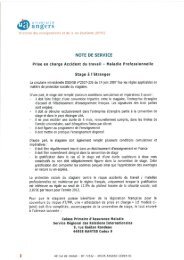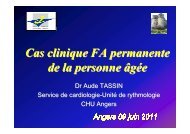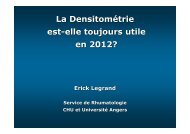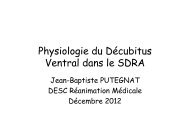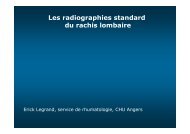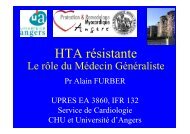Absence de conflit d’intérêt
A Armand Phlébite des membres inférieurs.pdf
A Armand Phlébite des membres inférieurs.pdf
You also want an ePaper? Increase the reach of your titles
YUMPU automatically turns print PDFs into web optimized ePapers that Google loves.
Que doit faire le mé<strong>de</strong>cingénéraliste <strong>de</strong>vant unephlébite?<strong>Absence</strong> <strong>de</strong> <strong>conflit</strong> <strong>d’intérêt</strong>A Armand-PerrouxUrgences- CHU Angers
Thrombose veineuse : Généralités• Maladie thrombo embolique (MTEV) : Emboliepulmonaire (EP) et thrombose veineuse (TV)• TV, mécanismes <strong>de</strong> survenue : Tria<strong>de</strong> <strong>de</strong> Virchow-> stase, lésion pariétale et hypercoagulabilité• Inci<strong>de</strong>nce en France 1,24 /1000 hab par an : sousévaluation ?• Risque immédiat : extension proximale, EP• Risque <strong>de</strong> récidive à moyen terme• Syndrome post phlébitique à long terme
Facteurs <strong>de</strong> risque• Âge : inci<strong>de</strong>nce annuelle 5% après 75 ans• Facteurs hormonaux : grossesse, postpartum, contraception par OP, traitementhormonal substitutif par oestrogènes• Chirurgie : classification <strong>de</strong>s risques• Immobilisation : plâtre, allitement• Affection médicale aiguë :• Thrombophilie• Cancer : 15 à 20% <strong>de</strong>s MTEV
Généralités• Estimation <strong>de</strong>s risques <strong>de</strong>vant toutesituation pathologique aiguë• Place prévention• Facteurs favorisants : recueilindispensable <strong>de</strong>vant toute suspicion<strong>de</strong> thrombose veineuse• Estimation score <strong>de</strong> probabilité ->stratégie diagnostique
Stratégie diagnostique• 2 étapes initiales:- Évaluation score <strong>de</strong> probabilité cliniqueinitial- Choix <strong>de</strong>s examens complémentaires : typeet chronologie• Permet- Prise en charge thérapeutique précoce etadaptée- Choix orientation• À adapter à recherche TV profon<strong>de</strong> ousuperficielle
Physiopathologie• La tria<strong>de</strong> <strong>de</strong> Virchow associe:– L’altération <strong>de</strong> la paroi veineuse• Traumatique• Irritative• septique– La stase veineuse• Immobilisation• Compressions extrinsèques• Insuffisance veineuse– L’activation <strong>de</strong>s facteurs <strong>de</strong> coagulation• Thrombophilie héréditaire ou acquise• Traumatismes• Facteurs généraux
Rappels anatomiquesIliaque externeThromboses proximalesFémorale superficielleFémorale profon<strong>de</strong>Tronc tibio péronierpoplitéeTibiale antérieureThromboses distalesTibiale postérieure
Diagnostic• Clinique peu contributive: douleur <strong>de</strong> jambe,œdème, signes inflammatoires locaux• PROBABILITE CLINIQUE: associe signeslocaux, terrain (facteurs <strong>de</strong> risque) etdiagnostic différentiel• Utilisation <strong>de</strong> SCORES: <strong>de</strong> Wells, <strong>de</strong> Genève• Résultat : faible, intermédiaire ou fort• Recherche systématique signes en faveur EPassociée : évaluation aux urgences• INTERET CERTITUDE DIAGNOSTIQUE
Score <strong>de</strong> Wells modifié 2003 : 10 items- Terrain/ FR (sur 4)• Cancer évolutif +1• Paralysie, parésie, plâtre3 jours, chirurgie majeure < 1 mois +1• Antécé<strong>de</strong>nt <strong>de</strong> TVP documentée +1- Signes locaux (sur 5)• Douleur à la palpation <strong>de</strong>s axes veineux +1• Œdème <strong>de</strong> tout MI +1• Augm. circonf. mollet >3 cm/opposé +1• Œdème , go<strong>de</strong>t + +1• Collatéralité <strong>de</strong> suppléance veineuse +1- Autre diagnostic• Autre diagnostic probable -2Probabilité clinique- faible /= 2WELLS PS NEJM 2003, 349: 1227-35
Stratégie diagnostique• Estimation d’une probabilité clinique• Dosage D-Dimères-> Limites : Sepsis, CIVD, Cancer, Pathologieinflammatoire, Hématome,Traumatisme,Grossesse• Echo doppler complet (en France)
D-dimères pour TV• Étu<strong>de</strong> contre référence ( écho dopplerou phlébographie)sensibilitéVPNTV proximale 98% 94%TVP distale 76% 80%Ensemble 92% 76%Leroyer C et all. thrtomb haemost1997; 77: 637-640
D-dimères pour TVPTest Spécificité Sensibilité RVNELISA quantitatif rapi<strong>de</strong>(VIDAS)44% 96% 0.09ELISA qualitatif (Nyocard) 47% 93% 0.15Latex quantitatif (Liatest,Tina Quant, IL test)Latex semi-quantitatif(Accuclot)Hémagglutination(SimpliRED)66% 85% 0.2466% 78% 0.3383% 87% 0.16Stein PD et al. Ann Intern Med2004; 140: 589-602
Stratification risque TVPSuspicion <strong>de</strong> TVPprobabilité cliniqueFaible : ≤ 1 Forte : ≥ 2DD - DD +TVP + TVP +TVP +Risque TE à 0,9%3 mois4,5%27.9%Retour domicileNi ED ni TTTpoursuite stratégieWELLS PS NEJM 2003, 349: 1227-35
Echo doppler veineux• Examen en pratique courante : non invasif, rapi<strong>de</strong>,reproductible• Sensibilité > 96% et spécificité 94% pour l’étageproximal• Régies par l’expérience <strong>de</strong> l’examinateur, le type <strong>de</strong>machine utilisée, le type d’exploration (proximale oudistale) et la présence d’une TVP symptomatique ounon• Non compressibilité sous la son<strong>de</strong>, mo<strong>de</strong> dopplerpour axes iliaques• En France : examen complet <strong>de</strong>s axes veineux• Pays anglo-saxons : exploration proximale répétée
Exploration en ED <strong>de</strong>s TVsuperficielles ?• Extension en ED fréquemmentsupérieure à extension clinique• Recherche TVP « muette » associée• Évaluation extension et limite proximale<strong>de</strong> TV• Exploration complète dans suspicion EP• Risque évolutif ?
Suspicion TVPScore <strong>de</strong> probabilitéfortintermédiairefaibleTt d’attenteD Dimère+ -+ED complet-Tt anticoagulantArrêt
Thérapeutique• Selon localisation du thrombus• Selon présence ou non <strong>de</strong> facteur favorisant• Selon terrain• Traitement ambulatoire
Traitement à la phase initiale <strong>de</strong> la TVPHBPM : une ou <strong>de</strong>ux injections sc par jour- en ambulatoire si possible 1C- Pas <strong>de</strong> nécessité d’une surveillance <strong>de</strong> activité anti-Xa 1A- En cas d’insuffisance rénale sévère, préférer HNF en IV 2C- Pas <strong>de</strong> thrombolyse 1ASauf si TVP massive avec risque <strong>de</strong> gangrène secondaire 2C- Pas d’indication <strong>de</strong> filtre cave 1ASauf si contre-indication aux anticoagulants2COu si récidive vraie sous anticoagulation efficace2C- Pas d’indication <strong>de</strong>s AINS à la phase initiale TVP 2B1A-Déambulation précoce recommandée1B-Relai AVK à J 1 dès confirmation diagnostiqueNational Gui<strong>de</strong>line Clearinghouse (www.gui<strong>de</strong>line.gov)Chest 2004 ; 126 : 401s-28s
Traitement initial TVPFamille DCI NomcommercialPosologieNombreinjectionspar jourHNFHéparinecalciqueCalciparine® 500 UI/Kg/J 2 à 3HBPMDaltaparineEnoxaparineFragmine®Lovenox®100 UI/ kg/12h100 UI/ kg/12h12NadroparineFraxiparine®0,1 ml/kg/12h2TinzaparineFraxodi®Innohep®0,1 ml/kg/24h175 UI/kg/12h11Antithrombotique Fondaparinux Arixtra® Poids < 50 kg : 5 mg/j50 à 100 kg : 7,5 mg/jPoids > 100 kg : 10mg /j1Mismetti P, Decousus H, Moulin N. Traitement initial <strong>de</strong> la maladie thrombo-embolique veineuse. Rev Prat. 2007 ;57 :751-8.
CI au traitement anticoagulant•Coagulopathie sévère constitutionnelle ou acquise(thrombopénie < 30 000/mm3, hémophilie…)•Hémorragie intracrânienne spontanée•Hémorragie active non facilement contrôlable•Chirurgie récente (délai dépend du type <strong>de</strong>chirurgie)•ATCD thrombopénie à l’héparine (ne contreindiquepas les AVK)Le rapport risque / bénéfice doit être évalué <strong>de</strong> façonindividuelle pour chaque patient
•Surveillance plaquettaireEffets secondaires-Thrombocytopénie induite: fréquence autours <strong>de</strong> 1 à3%, 5 à 10 fois moins fréquente avec les HBPM(mécanisme immunoallergique, survenant entre le5ème et 10ème jour)Pas <strong>de</strong> surveillance plaquettairesur traitement court•Activité anti Xa : RIEN DE SYSTEMATIQUE-Surveillance risque surdosage: insuffisance rénale,sujet âgé, poids extrêmes•Risque hémorragique-chez le sujet âgé (> 75 ans) et l’insuffisant rénal(clairance créatinine < 30)
Relai AVK-Relai AVK à J 1 dès confirmation diagnostique (en <strong>de</strong>hors cancer)- INR zone cible 2,5 (2 – 3) 1A- Sur dosage : INR > 3,1; sous dosage INR < 1,9 1A- En cas <strong>de</strong> traitement prolongé, réévaluation régulière durapport bénéfice/risque1C-Préferer la warafarine COUMADINE® au flundionePREVISCAN® : stabilité après atteinte INR cible- Antithrombotic therapy for venous thromboembolic disease : VIIeme ACCP consensus conference on Antithrombotic and Thrombolytic Therapy- Ansell J, Hirsh J, Hylek E, Jacobson A, Crowther M, Palareti G. Pharmacology and management of the vitamin K antagonists:American College of Chest Physicians Evi<strong>de</strong>nce-Based Clinical Practice Gui<strong>de</strong>lines (8th Edition). Chest 2008;133:160S-98S.1
Durée traitement TVP- 1er épiso<strong>de</strong> avec facteur <strong>de</strong> risque transitoireAVK maximum 3 moisrecommandation pour TV distales symptomatiquesou TV proximale- 1er épiso<strong>de</strong> TVP idiopathiqueAVK pour 6 à 12 moisdiscuter un traitement prolongé1A1A2A- Avec anomalie thrombophilique documentée 1AAVK pour 6 à 12 mois- TVP et cancerHBPM pour les 3 à 6 premiers moisdiscuter traitement prolongé si cancer évolutif1A1CAntithrombotic therapy for venous thromboembolic diseaseVIIeme ACCP consensus conference on Antithrombotic and Thrombolytic Therapy
Durée du traitement dans la TVP distale et la TVsuperficielleTraitementFacteurs favorisantDurée <strong>de</strong>traitementGra<strong>de</strong> <strong>de</strong>srecosTVP Distale 1 èrépiso<strong>de</strong>AVKFacteur déclenchantévi<strong>de</strong>ntFacteur transitoire6 semaines CTVP Distalerécidivante ,idiopathique oufacteur persistantAVK Cancer évolutif ≥ 3 moisAccordprofessionnelTVS simpleHBPMprophylactiqueVarices7 à 30 joursAccordprofessionnelTVS étenduegran<strong>de</strong> saphène –veine fémoraleHBPMcuratif7 à 30 joursAccordprofessionnelAFSSAPS 2009 -24
Contre-indications autraitement ambulatoire• Générales:- Nécessité médicale d’hospitalisation (comorbidité)- Risque d’inobservance du traitement- Grossesse- Impossibilité <strong>de</strong> suivi en externe et/ou <strong>de</strong> laprise en charge <strong>de</strong> la pério<strong>de</strong> <strong>de</strong>chevauchement HBPM-AVK- Environnement social absent ou inadapté:absence <strong>de</strong> téléphone, <strong>de</strong> domicile fixe,solitu<strong>de</strong>
Contre-indications au traitementambulatoire• Risque hémorragique ou thrombotiqueaccru- Syndrome hémorragique ou maladie hémorragiquefamiliale- Traitement AINS- Insuffisance hépatique sévère- Insuffisance rénale (clairance 120 Kg)- Aspects cliniques <strong>de</strong> la maladie thromboembolique- Douleur et œdème important du membre inférieur(phlegmatia caerulea dolens)- Suspicion clinique d’embolie pulmonaire !!!!!VIAL, LE CONTE: Modalités <strong>de</strong> prise en charge <strong>de</strong> la thrombose veineuse profon<strong>de</strong> par l’urgentiste. JEUR,2001, 14, 240-247
• Bas ou collants <strong>de</strong> contention pendant 18 mois• HBPM ou fondaparinux : auto injection?• Posologie <strong>de</strong> AVK à débuter à J1: préférerCoumadine® par rapport au Previscan®• Consignes claires pour chevauchement HBPMet AVK (5 jours)• Arrêt quand INR entre 2 et 3 : 2 jours <strong>de</strong> suite• Ordonnance pour contrôle d’INR• Contrôle plaquettes non obligatoire sur tt court,préférable sauf fondaparinux• Pas surveillance anti-Xa (sauf cas particulier :risque hémorragique)• Nouveau tt : antiXa en coursévaluation/validation
Bilan étiologique• Analyse <strong>de</strong>s FDR, antécé<strong>de</strong>nts, contexte <strong>de</strong>survenue et pathologies associées• Recherche facteur favorisant• Antécé<strong>de</strong>nts familiaux• Examen clinique complet• Bilan plus approfondi si TVP sans cause, <strong>de</strong>localisation inhabituelle, thrombosebilatérale, récidivante : pathologiecancéreuse• Equipe recherche SAU du CHU d’Angers :joignable pour toute question dans domaineMTEV
BibliographieRecommandations actuelles pour le traitement anticoagulant <strong>de</strong> lathrombose veineuse:- Antithrombotic therapy for venous thromboembolic disease:theSeventh ACCP Conference on Antithrombotic and ThromboliyticTherapy- Kearon C, Kahn SR, Agnelli G, Goldhaber S, Raskob GE, ComerotaAJ. Antithrombotic therapy for venous thromboembolic disease:American College of Chest Physicians evi<strong>de</strong>nce-based clinicalpractice gui<strong>de</strong>lines (8th edition). Chest 2008 ;133 :454S-545S.- National Gui<strong>de</strong>line Clearinghouse (www.gui<strong>de</strong>line.gov)- Chest 2004 ; 126 : 401s-28s- AFSSAPS 2009 -



